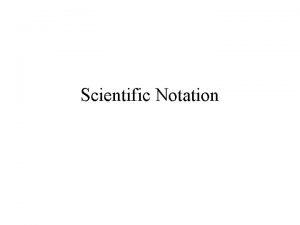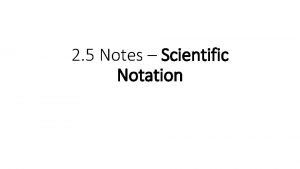Scientific Notation Notes Scientific Notation Method of simplifying







- Slides: 7

Scientific Notation Notes

Scientific Notation • Method of simplifying very large or small numbers. • Expresses any number between 1 and 10 (known as a coefficient) multiplied by 10 raised to a power (known as an exponent). • Ex. 4. 6 x 105

Expanding Scientific Notation - 4. 5 x 107 - Numbers raised to a positive exponent are larger numbers. - Shift the decimal to the right the number of times of the exponent.

Expanding Scientific Notation - 4. 5 x 10 -5 - Numbers raised to a negative exponent are smaller numbers (decimals). - Shift the decimal to the left the number of times of the exponent. 0. 000045

Putting Larger Numbers in Scientific Notation • 378000000 in scientific notation with 3 sig figs. • Remember even though it’s not written, there is decimal to the right of the last 0. • Shift the decimal over until it is to the right of the 1 st significant figure in the number • Count how many times the decimal moved (this is your exponent). • Rewrite the number with the decimal moved and “drop” the extra zeros until you have the desired number of sig figs. • Add the x 10 with the exponent equal to the number of times the decimal shifted.

Putting Small Numbers in Scientific Notation - 0. 000023 in scientific notation with 3 sig figs. - Shift the decimal over until it is to the right of the 1 st significant figure in the number. - Count how many times the decimal moved (this is your exponent – it will be NEGATIVE). - Rewrite the number with the decimal moved and “drop” the extra zeros until you have the desired number of sig figs. - Add the x 10 with the negative exponent equal to the number of times the decimal shifted.

Practice PAGE 41 in Textbook #s 11 & 12













